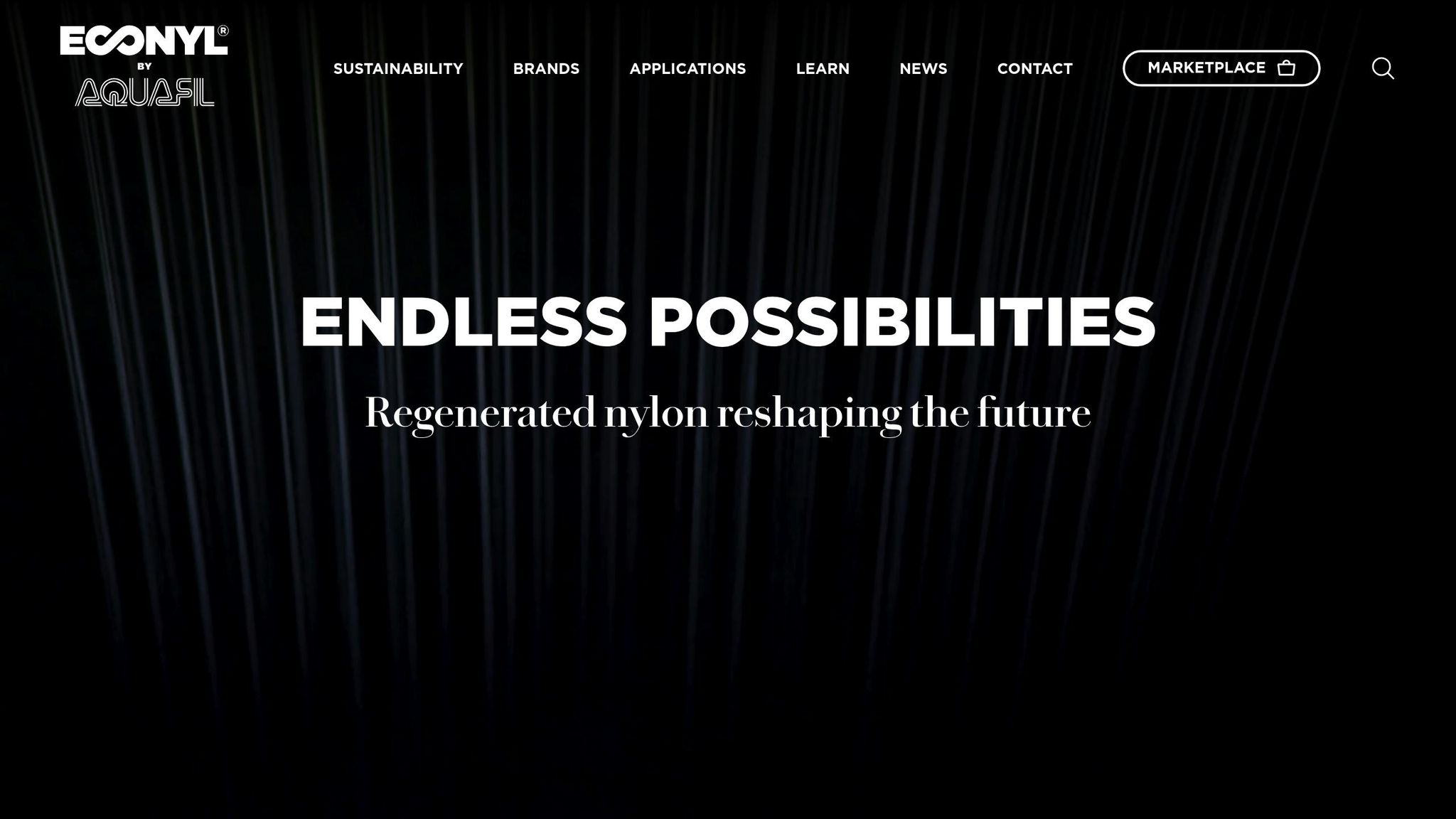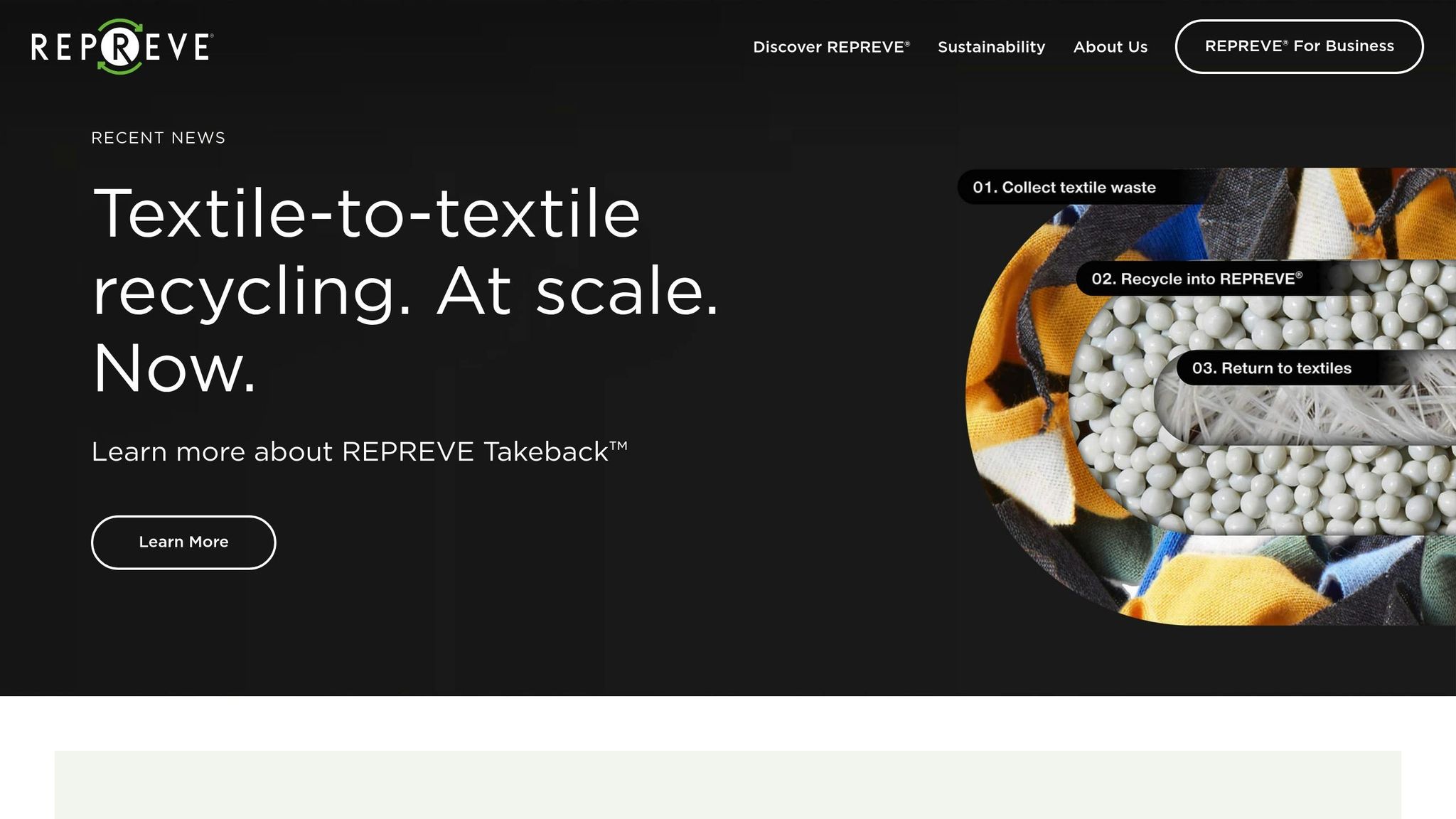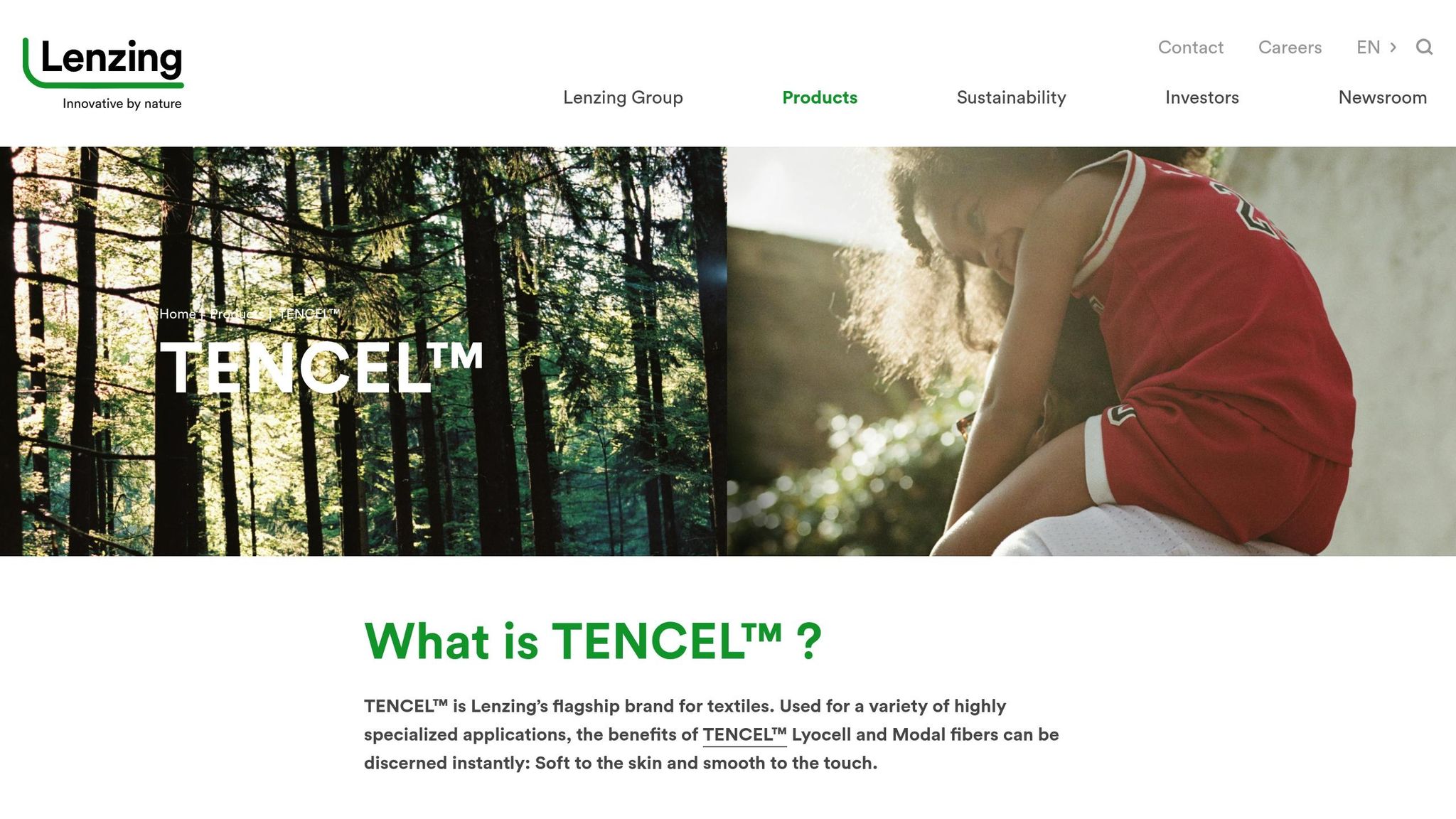Sustainable Swimwear: Top 8 Eco-Friendly Fabrics
Looking for eco-friendly swimwear options? Here's a quick guide to the top 8 sustainable fabrics transforming the swimwear industry. These materials reduce waste, cut emissions, and offer durability without compromising performance or style.
Key Fabrics:
- ECONYL Regenerated Nylon: Made from waste like fishing nets; endlessly recyclable.
- REPREVE Recycled Polyester: Created from plastic bottles; reduces ocean pollution.
- Organic Cotton: Grown without pesticides; uses less water and energy.
- Hemp Fabric: Strong, UV-resistant, and requires minimal resources.
- TENCEL Lyocell: Made from eucalyptus wood; biodegradable and resource-efficient.
- Recycled Nylon: Repurposes industrial waste; matches virgin nylon quality.
- Bamboo Textile: Fast-growing plant; moisture-wicking, UV-protective, and soft.
- Carvico Vita Fabric: Combines recycled nylon with elastane; chlorine and UV resistant.
Quick Comparison Table:
| Fabric | Key Benefits | Environmental Impact |
|---|---|---|
| ECONYL | Recyclable, high performance | Reduces ocean waste, saves oil |
| REPREVE | Durable, traceable origin | Prevents plastic pollution |
| Organic Cotton | Soft, pesticide-free | Saves water, reduces emissions |
| Hemp | UV-resistant, durable | Absorbs CO₂, no pesticides needed |
| TENCEL Lyocell | Biodegradable, strong | Minimal water and energy use |
| Recycled Nylon | Durable, versatile | Cuts energy use by 70% |
| Bamboo Textile | Moisture-wicking, UV-protective | Grows fast, no replanting needed |
| Carvico Vita | Chlorine-resistant, lightweight | Recycled materials, long-lasting |
Exploring The Zoggs Sustainable Ecolast+ Swimwear Fabrics
1. ECONYL Regenerated Nylon

Introduced by Aquafil in 2011, ECONYL takes waste materials and turns them into high-performance swimwear fabric with the same quality as virgin nylon.
This process is not just efficient - it saves around 70,000 barrels of crude oil for every 10,000 tons produced. The raw materials? Discarded fishing nets, fabric scraps, old carpet flooring, and industrial plastic waste [2].
"The ECONYL® Regeneration System starts with rescuing waste otherwise polluting the Earth, like fishing nets, fabric scraps, carpet flooring and industrial plastic all over the world. That waste is then sorted and cleaned to recover all of the nylon possible." - ECONYL [1]
Aquafil's U.S. facilities play a big role by processing large amounts of carpet waste, reinforcing the eco-friendly nature of ECONYL [1].
One standout feature of ECONYL is its ability to be recycled endlessly without losing quality. As Aquafil CEO Giulio Bonazzi puts it:
"When I see a landfill, I see a goldmine." [3]
In April 2019, Adidas showcased this material in its Parley swimwear collection, proving that ECONYL performs just as well as traditional nylon in technical applications [4].
Why ECONYL Works for Swimwear
- Ocean Waste Reduction: Transforms discarded fishing nets into something useful.
- High Performance: Matches the properties of virgin nylon.
- Long-Lasting: Can be recycled over and over without breaking down.
- Design Flexibility: Works for both high-performance and luxury swimwear.
ECONYL combines eco-consciousness with top-tier performance, making it an ideal choice for luxury swimwear brands looking to reduce their environmental footprint.
2. REPREVE Recycled Polyester

REPREVE is making waves in luxury swimwear by transforming post-consumer plastic bottles and textile waste into high-performance fiber. This certified material has already recycled over 40 billion plastic bottles, playing a crucial role in reducing waste and protecting the environment [5].
The process starts with collecting plastic bottles from within 31 miles of coastal areas in developing countries. This effort helps prevent plastic from polluting oceans. Unifi, the company behind REPREVE, then processes these materials - along with post-industrial and post-consumer polyester waste - into certified fiber, resin, and yarn [5].
"REPREVE® is a performance fiber and resin, traceably-made from recycled materials and waste sources. Using recycled materials instead of virgin produces fewer carbon emissions and protects natural resources." - REPREVE [6]
To ensure quality and traceability, REPREVE uses its proprietary FiberPrint technology. This system embeds a tracer in the material, allowing verification of its origins through U-TRUST certification [5].
REPREVE tackles pressing environmental issues head-on. With humans consuming around 1.2 million plastic bottles every minute - and only 56% being recycled [6] - this material offers practical solutions:
- Waste Reduction: Helps keep plastic out of oceans.
- Lower Emissions: Reduces carbon output by using recycled materials instead of new ones.
REPREVE is available globally, ensuring consistent quality and accessibility in major textile markets. It matches the performance of traditional polyester while staying eco-friendly, proving that sustainability and durability can go hand in hand.
3. Organic Cotton
Organic cotton is a standout choice among eco-friendly materials, offering a natural fiber with a smaller environmental footprint. Its properties align well with the performance and sustainability demands of high-end swimwear.
Here's why organic cotton matters: Conventional cotton farming consumes a staggering 25% of the world's insecticides and over 10% of its pesticides to produce 20 million tons annually. In contrast, organic cotton avoids synthetic chemicals, resulting in impressive savings - 218 billion liters of water and 288.7 million kilowatts of energy each year. Plus, CO2 emissions drop by 92.5 million kilograms, which is like taking 20,000 passenger cars off the road annually [7]. These benefits are achieved through organic farming methods like composting, crop rotation, and cover cropping, all of which focus on maintaining soil health.
When used in swimwear, organic cotton is often blended with small amounts of stretch materials, such as elastane or lycra, to ensure flexibility and durability. Some brands leading the way in this space include:
| Brand | Material Composition |
|---|---|
| Luz Swimwear | 93% organic cotton, 7% elastane |
| Ambika Boutique | 98% cotton, 2% elastane |
| Hemp Huggers | Organic hemp-cotton blend with 3% lycra |
| Natasha Tonic | Hemp-organic cotton blend with 4% lycra |
For the best results, rinse organic cotton swimwear thoroughly after exposure to chlorinated water to keep it in top condition [8]. Look for certifications like USDA's NOP, OCS, or GOTS to ensure the materials meet organic standards and are produced responsibly [7].
4. Hemp Fabric
Hemp fabric stands out for its strength and minimal impact on the environment, making it a smart choice for luxury swimwear.
Hemp offers significant environmental benefits. It absorbs 9–15 tons of CO₂ per hectare and grows quickly with deep roots, reducing the need for pesticides while protecting soil health [10]. On top of that, hemp is incredibly efficient, producing 250% more fiber than cotton and 600% more than flax on the same amount of land [12]. This high yield makes it a resource-efficient option for fabric production.
Here’s why hemp fabric works well for swimwear:
| Property | Benefit for Swimwear |
|---|---|
| UV Resistance | Naturally protects against sun exposure |
| Breathability | Keeps wearers dry with great moisture-wicking |
| Durability | Stronger than cotton, ensuring long-lasting wear |
| Comfort | Becomes softer over time without losing its shape |
These qualities make hemp fabric highly effective in water-related activities.
"Considered to be one of the most environmentally friendly fabrics, hemp is naturally resistant to pests, requires relatively little water, and grows quickly. Hemp is a 'sister plant,' meaning it replenishes the soil for the crops around it and is ideal for crop rotation. Hemp feels like a new linen, softening with each wash and wear." – Mara Hoffman [12]
Hemp is also efficient in production, with thread counts typically ranging from 200 to 400 per inch [9]. This ensures excellent coverage and durability, perfect for high-end swimwear designs.
To enhance swimwear functionality, hemp is often combined with other eco-friendly fibers. These blends improve stretch and flexibility while maintaining its environmental advantages. Its breathability and moisture-wicking properties make it a go-to material for designers focused on sustainable, stylish swimwear [11].
sbb-itb-ca21a95
5. TENCEL Lyocell

TENCEL™ Lyocell is a fabric developed by Lenzing, made through a closed-loop process that turns eucalyptus wood pulp into fibers. This method recovers nearly all the non-toxic solvent used, cutting down on waste and pollution.
Here’s how TENCEL™ Lyocell performs in key areas:
| Aspect | Metric |
|---|---|
| Water Use | 95% less water than conventional cotton |
| Solvent Recovery | 99% of solvents are recycled |
| Biodegradability | Fully breaks down in 30 days in ocean conditions |
| Resource Efficiency | Produces 4x more fiber per acre compared to cotton |
| Wet Strength | Keeps 85% of its strength when wet |
These features make it a great choice for swimwear. The fabric holds its shape, wicks moisture, and provides comfort during water activities. With thread counts ranging from 300 to 600[14], it offers excellent coverage and durability.
Rex Mok, Vice President of Fiber Technical Marketing and Development at Lenzing, highlights its versatility:
"Our technical innovation unlocks the inherent potential of TENCEL™ Lyocell fibers for producing stretch fabrics that move in harmony with the body. This enhances comfort with easy-to-care properties, making it ideal for lightweight apparel"[15].
What makes TENCEL™ Lyocell stand out?
- Hypoallergenic properties that are gentle on sensitive skin
- Odor resistance for lasting freshness
- Wrinkle resistance, keeping its shape even after repeated use
- Free of harmful toxins and microplastics
Caring for TENCEL™ Swimwear
- Wash with cold water on a gentle cycle
- Use mild, eco-friendly detergents
- Air dry or use a low heat setting
- Iron on low if needed
Additionally, REFIBRA™ technology blends at least 30% recycled material from pre- and post-consumer waste[13], boosting sustainability while maintaining quality.
6. Recycled Nylon
Recycled nylon takes waste materials and transforms them into a durable, high-performance fabric. Beyond ECONYL, this process taps into diverse waste streams to create nylon that matches the quality of virgin nylon while lowering its impact on the planet.
The process involves collecting and repurposing various waste sources, such as:
| Waste Source | Impact on the Environment |
|---|---|
| Carpet Waste | Keeps waste out of landfills |
| Fishing Nets | Helps reduce ocean pollution |
| Industrial Plastic | Lowers dependence on crude oil |
| Fabric Scraps | Cuts down on manufacturing waste |
Recycling nylon uses around 70% less energy compared to producing new nylon [16]. Companies like Aquafil Group are leading the way, with facilities in Phoenix and Woodland, California, recycling up to 36 million pounds of carpet annually [1].
Performance Features
Recycled nylon is just as strong and resilient as virgin nylon, ensuring it holds up throughout its lifecycle.
What to Look For in Recycled Nylon Swimwear
When shopping for swimwear made from recycled nylon, keep these points in mind:
- Certified Recycled Nylon: Look for official certifications to confirm the material's authenticity.
- Seam Quality: Check that seams are even and strong.
- Fabric Durability: Ensure the material feels substantial and long-lasting.
- Clean Finishes: Avoid pieces with irregular stitching or unfinished edges.
Since the 1990s, companies like Aquafil have been perfecting the recycling process to ensure recycled nylon retains its technical properties while offering a more sustainable option. This makes it a dependable and eco-conscious choice for luxury swimwear.
7. Bamboo Textile
Bamboo textile combines luxury with eco-conscious qualities, making it a great choice for premium swimwear.
How Bamboo Grows and Becomes Fabric
Bamboo is an incredibly fast-growing plant that doesn’t need replanting after harvest. Its natural ability to fend off pests means no pesticides or chemical fertilizers are required [17].
There are two main ways bamboo is turned into fabric:
| Processing Method | Environmental Impact | Fabric Characteristics |
|---|---|---|
| Mechanical | Lower impact; keeps natural qualities intact | Produces a linen-like texture with antimicrobial properties |
| Chemical (Viscose) | Higher impact; uses sodium hydroxide | Creates a silkier texture but reduces some natural benefits |
Why Bamboo Works for Swimwear
Bamboo fabric has several standout qualities that make it perfect for swimwear:
- Moisture-wicking: It absorbs 40% more moisture than standard fibers [17].
- UV protection: Blocks up to 98% of harmful UV rays and offers 60% more sun protection than cotton [17].
- Comfortable fit: Its anti-static nature prevents clinging, even during water activities.
Eco-Friendly Advantages
Bamboo is an environmentally smart material for several reasons:
- Produces 50 times more fiber per acre compared to cotton [18].
- Needs very little irrigation [17].
- Naturally decomposes when discarded [17].
- Some species grow as much as four feet in a single day [19].
On top of these environmental perks, bamboo fabric is also highly effective in water.
How Bamboo Performs in Water
Bamboo fabric absorbs three times more water than other materials while staying twice as strong as polyester. It dries quickly, holds its shape, and stands up to repeated exposure to salt water and sunlight [19]. This makes it a durable and reliable option for swimwear.
8. Carvico Vita Fabric

Carvico Vita takes recycled nylon to the next level by combining eco-conscious materials with high performance. This fabric, designed for swimwear, is made from 78% recycled polyamide and 22% elastane. It uses ECONYL® Nylon yarn, which transforms waste - both pre-consumer and post-consumer - into top-quality material.
Technical Specifications
| Specification | Details |
|---|---|
| Weight | 190 GR/M2 |
| Width | 59 inches (150 cm) |
| Roll Length | 76.55 yards (70 meters) |
Performance Features
Carvico Vita stands out with double the resistance to chlorine, sunscreens, and oils compared to regular fabrics [20]. Key features include:
- Chemical and UV Protection: Shields against chlorine, pool chemicals, and harmful UV rays.
- Resistance to Sunscreens and Oils: Handles exposure to these substances without degrading.
- Shape Retention: Keeps its form even after heavy use.
Comfort and Functionality
The fabric's design ensures both comfort and practicality, offering:
| Feature | Benefit |
|---|---|
| Bi-elastic Structure | Enables unrestricted movement in all directions. |
| Ultra-thin Profile | Lightweight feel without sacrificing coverage. |
| Muscular Containment | Provides gentle compression while staying flexible. |
| Pilling Resistance | Maintains a smooth surface over time. |
Versatility Beyond Swimwear
Carvico Vita isn’t limited to swimwear. Its adaptability makes it ideal for:
- Competition-level athletic apparel
- High-performance sportswear
- Premium footwear components
- Luxury furnishing materials
With its durable and eco-friendly design, Carvico Vita is built to last, offering comfort and resilience in demanding conditions.
Key Points to Remember
When selecting swimwear made from eco-conscious materials, keep these practical tips in mind to make smarter choices.
Performance Requirements
Look for swimwear fabrics that meet these performance benchmarks:
| Feature | Minimum | Optimal |
|---|---|---|
| Stretch Capacity | 50% in all directions | Spandex blends (up to 500%) |
| Chlorine Resistance | 600 hours | PBT fabric (800 hours) |
| Elastane Content | 8% minimum | Premium elastane blend |
| UV Protection | UPF 30+ | UPF 50+ |
Material Selection Guidelines
Match the fabric to your primary swimwear use:
| Activity Type | Recommended Fabric | Benefits |
|---|---|---|
| Recreational Swimming | Recycled Nylon | Quick-drying, soft feel |
| Athletic Performance | Recycled Polyester | High chlorine resistance |
| Beach Lounging | Bamboo/Cotton Blends | Comfort and breathability |
| Family Activities | REPREVE | Durability and sun protection |
Care and Maintenance
Extend the life of your swimwear with these care tips:
- Rinse with cold water immediately after use.
- Hand wash to maintain fabric quality.
- Avoid wringing or twisting.
- Air dry in a shaded area.
Environmental Impact
Choosing sustainable fabrics helps reduce waste and pollution. Here’s why it matters:
- The fashion industry ranks as the second-largest polluter globally [22].
- Around $170 million worth of clothing ends up in UK landfills annually [22].
- Recycled options like ECONYL and REPREVE help cut down plastic waste [21].
Fabric Weight Guide
Select the right fabric weight for your needs:
| Weight (GSM) | Best For | Characteristics |
|---|---|---|
| 150 | Casual Wear | Lightweight, soft feel |
| 180-200 | All-Purpose | Balanced coverage and comfort |
| 220+ | Competition | Maximum support and durability |


Leave a comment